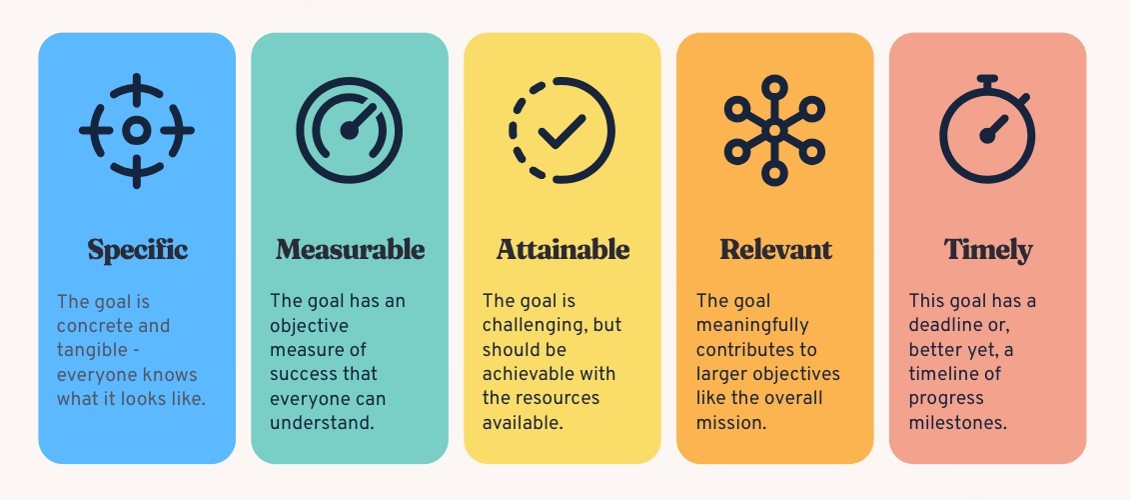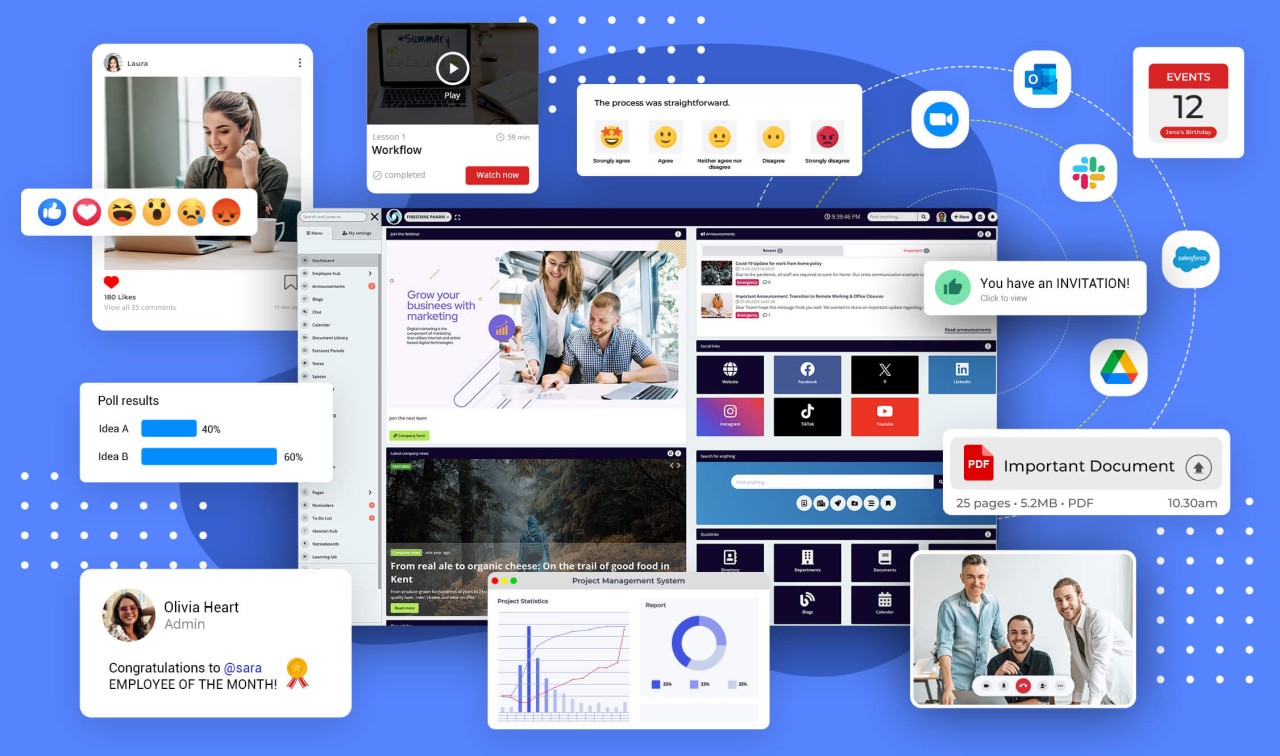Insight Blog
Agility’s perspectives on transforming the employee's experience throughout remote transformation using connected enterprise tools.
17 minutes reading time
(3453 words)
How to Write SMART Goals for Employees in 2024
A SMART goal is used to help guide goal setting. SMART is an acronym that stands for Specific, Measurable, Achievable, Realistic, and Timely. Goals are part
As an HR manager, grasping the power of setting development goals is pivotal for charting career paths and empowering employees to achieve their professional aspirations. In any industry or role, goal setting is a key driver of growth and advancement.
However, many individuals feel daunted by their ambitions.
The question then becomes: how can one bridge the gap between their current position and ultimate career objectives?
Research reveals that 80% of people never set goals, and of those who do, approximately 70% fail to achieve them. This high failure rate is often attributed to a lack of specificity in goal-setting. To boost the likelihood of success, it's crucial to break down larger objectives into smaller, clearly defined, and realistic steps.This is where the SMART method, comes in offering a structured approach that significantly increases the chances of goal achievement and the subsequent sense of accomplishment.
From an HR perspective, advocating for the use of SMART goals can markedly enhance employee performance and satisfaction. The impact is significant: employees who set and achieve specific goals are 42% more likely to report high job satisfaction.
From an HR perspective, advocating for the use of SMART goals can markedly enhance employee performance and satisfaction. The impact is significant: employees who set and achieve specific goals are 42% more likely to report high job satisfaction.
Its also worth mentioning, organizations that foster a goal-setting culture experience 20% higher employee engagement and 27% greater profitability, underscoring the direct correlation between goal-setting and organizational success, and the crucial role each individual plays in this success.
In this article, we will explore SMART goals, why they are pivotal for career development, and how to effectively set and achieve them.
In this article, we will explore SMART goals, why they are pivotal for career development, and how to effectively set and achieve them.
To make the concept more relatable, we will provide inspiring examples such as 'Increase sales by 10% in the next quarter' or 'Complete a professional certification within six months '. These examples will help you to visualize the process and its benefits as you begin your goal-setting journey.
Adopting this approach not only aids in individual career advancement but also enhances overall organizational success.
What are SMART Goals?
As an HR manager, understanding and implementing effective goal-setting strategies is not just crucial, but a responsibility, for guiding your team's development and aligning their efforts with organizational objectives. Goals are integral to every aspect of business and life, providing direction, motivation, clear focus, and a sense of priority.
By setting well-defined goals, you establish targets for your team to aim for, ensuring their efforts contribute meaningfully to overall success, and you play a pivotal role in this process.The SMART goal framework is an invaluable tool in this process. SMART goals at work is a great way to keep employees engaged it stands for Specific, Measurable, Achievable, Realistic, and Timely. This method helps structure goal-setting in a way that maximizes clarity and feasibility.
By incorporating these criteria, SMART goals ensure that objectives are clear and attainable, providing a roadmap that instills confidence in your team's efforts and your guidance.
Here's why SMART goals are essential for HR managers:
As an HR manager, your role in guiding your team to set SMART goals is crucial.
Here's why SMART goals are essential for HR managers:
- Specific: Clearly defined goals eliminate ambiguity, allowing team members to understand what is expected.
- Measurable: Quantifiable goals enable you to track progress and measure success, providing a basis for feedback and adjustments.
- Achievable: Realistic goals ensure that objectives are within reach, maintaining motivation and reducing the likelihood of frustration.
- Relevant: Goals aligned with broader organizational aims ensure that efforts are directed towards meaningful outcomes. For example, if the organizational aim is to increase customer satisfaction, an individual SMART goal could be 'Improve customer response time by 20% within the next month '.
- Timely: Setting deadlines creates a sense of urgency and helps prioritize tasks, ensuring steady progress.
As an HR manager, your role in guiding your team to set SMART goals is crucial.
This approach not only enhances their individual performance and satisfaction but also contributes to the overall productivity and success of your organization. It provides a structured pathway to achieving both personal and organizational ambitions.
Your support in providing resources, feedback, and recognition is vital in fostering a culture of continuous improvement and goal attainment.
The Importance of SMART Goal Setting
Often, individuals or businesses set themselves up for failure by establishing vague and unrealistic goals, such as 'I want to be the best at sales.' Such goals lack the clarity and direction that SMART goals provide. By choosing to set SMART goals, you are making a wise and strategic choice that can significantly improve your chances of success.
SMART goals, on the other hand, empower you for success by ensuring that objectives are Specific, Measurable, Achievable, Realistic, and Timely. This method provides a clear path, helping you to stay focused, organized, and motivated as you work towards your objectives, giving you the control to steer your own success.
Here's how SMART goals make a difference:
- Specific: Instead of saying, "I want to be the best at X," a particular goal would be, "I want to improve my sales skills to increase my client base by 20% over the next six months."
- Measurable: A measurable goal allows you to track progress. For example, "I will complete five sales training courses and secure ten new clients by the end of the quarter."
- Achievable: Goals should be challenging yet attainable. Rather than setting an impossible target, aim for something like, "I will increase my weekly sales calls by 10%."
- Realistic: Given your resources and constraints, your goals should be realistic. For instance, "I will allocate three hours daily to prospecting new clients."
- Timely: Setting a deadline creates urgency and focus. For example, "I aim to achieve a 20% increase in sales within the next six months."
By following the SMART framework, you can practically transform vague aspirations into actionable plans, significantly enhancing your chances of success.
SMART goals are not just theoretical concepts, but practical tools that you can use to achieve your goals.
3 SMART goals examples for employees
Ready to begin? Before crafting your easy smart goals for work, explore these five examples to see how they align with the SMART criteria and provide a clear path to success.
Here are 3 smart goals examples for work:
#1.Business SMART goal example
As an HR manager, setting clear and compelling business goals is vital for organizational success. Here's an example of a SMART business goal, along with an explanation of why it meets the SMART criteria:
Business Goal Example: Create at least three types of large-scale marketing assets (e.g., eBook, webinar, videos, sales one- or two-pagers) each month for Q1.
Why it's SMART: This goal is:
- Specific: It clearly defines the type of marketing assets to be produced.
- Measurable: It specifies the production of three different types of assets.
- Achievable and Realistic: Assuming adequate team resources, producing three assets per month is attainable.
- Time-bound: It sets a clear timeframe by targeting Q1 for completion.
This approach ensures the marketing team has a focused and structured goal, which is essential for maintaining productivity and achieving strategic objectives.
#2.Team SMART goal example
Establishing precise team goals is not just a task, but a powerful tool that not only empowers your team to collaborate but also puts you in a position of influence, steering your team towards achieving organizational milestones.
Here's an example of a SMART team goal, with an explanation of its alignment with the SMART criteria:
Team Goal Example: The product team, with their unique skills and expertise, will not just work on, but collaborate on five cross-functional projects focused on usability testing, customer surveys, customer marketing, or research and development during the first half of FY22.
Why it's SMART: This goal is:
- Specific: It clearly defines the types of projects (usability testing, customer surveys, customer marketing, research, and development).
- Measurable: It sets a target of completing five cross-functional projects.
- Achievable: Given that 76% of cross-functional teams report improved performance and innovation, aiming for five projects in six months is feasible.
- Realistic: The goal leverages the entire product team, ensuring manageable workload.
- Time-bound: It specifies the timeframe as the first half of FY22.
By setting this SMART goal, you ensure that the product team remains focused, collaborative, and most importantly, aligned with broader organizational objectives.
This strategic alignment ultimately enhances overall performance and innovation, making you a key driver of organizational success.
Follow us and access great exclusive content everyday: Follow us on Google News
#2.Employee SMART goal example
SMART goal examples promoting professional development through clear goal setting is crucial for nurturing organizational talent and leadership. Professional smart goal examples, are pretty much the same as employee goals.
Here's an example of a SMART employees goal, along with an explanation of why it meets the SMART criteria:
Professional Goal Example: During 2021, I will enhance my management skills by mentoring at least two individuals from our company Employee Resource Groups or my alumni network.
Why it's SMART: This goal is:
- Specific: It focuses on developing management skills through mentorship.
- Measurable: It sets a clear target of mentoring at least two individuals.
- Achievable and Realistic: By offering two avenues (Employee Resource Groups and alumni network), the goal is attainable and realistic, considering the availability of mentees.
- Time-bound: It establishes the timeframe as the year 2021.
According to a Gartner study, 70% of employees who receive mentorship report higher job satisfaction and increased productivity.
By setting this SMART goal, you ensure that the individual enhances their management skills and contributes to the professional growth and satisfaction of others within the organization.
Crafting SMART Goals in 6 Simple Steps
Ready to take charge and craft your own SMART goal? Start by summarizing your project objective in a concise statement. Then, refine it using the SMART criteria, empowering yourself in the process.
For a practical and effective goal-setting process, utilize this SMART goals template to practice setting objectives with confidence.
- Start with your initial goal, a valuable starting point that doesn't need to meet all SMART attributes at first. Original: I aim to enhance our company's social media brand presence.
- Specificity check: Does your goal clearly outline your project? Adjust the wording to suit your goal. Revision: Enhance our company's Instagram brand presence by introducing unique company hashtags.
- Measurement clarity: Have you determined how to gauge success or failure? Add a measurable aspect to assess the outcome. Revision: Introduce company hashtags to attract 1,000 new Instagram followers.
- Achievability assessment: Is your goal realistic within the project's scope? Ensure it aligns with your capabilities. Revision: Combine company hashtags with industry-related ones to attract 1,000 new Instagram followers.
- Reality check: Can your team feasibly reach the goal? Confirm it's within reach with your available resources. Revision: Commit to daily Instagram posts featuring both company and industry hashtags to attract 1,000 new followers.
- Time-bound specification: When do you expect to achieve the goal? Set a clear deadline for accountability. Revision: Continue posting daily on Instagram throughout the first half of FY22, aiming for 1,000 new followers by June 30th.
You may also like: Best Apps for Employees: UPDATED 2022 – A Complete Guide
Common mistakes in setting goals
- Shifting Focus from Goals to Metrics: Instead of solely relying on metrics like response time, define their parameters clearly to ensure they're elevated to the status of a fully-fledged goal.
- Emphasizing Relevance: While managers might grasp the significance behind set goals, their active role in weaving each goal into a larger narrative is essential. This not only aids in decision-making but also cultivates a shared understanding among team members, emphasizing their crucial contribution to the process.
- Eliminating Zombie Goals: Acknowledging that our decision-making processes aren't flawless, it's imperative to address irrelevant goals. By explicitly disavowing defunct goals, providing explanations, and introducing new ones if needed, we ensure a fair and transparent goal-setting process. Neglecting this can foster a sense of apathy toward goals, which we strive to avoid.
- Underlining the Role of aligning Goals with Responsibilities: Ensure individuals responsible for output metrics possess the autonomy to determine how to achieve them. This trust in their abilities not only empowers them but also fosters a sense of ownership and commitment to the goals. Conversely, those tasked with specific actions should only be held accountable for metrics within their control. Distinguish between 'do-ers' and 'deciders' to assign SMART goals appropriately.
A good example could be, a developer's SMART goal could be setting up a new client relationship system, focusing on controllable input metrics.
Conversely, the head of customer service should aim for output metrics like reducing customer complaint response times, aligning with their decision-making role.
This prevents individuals from being solely responsible for "input" metrics, allowing them to drive meaningful impact.
Implementing SMART Goals
To ignite your goal-setting journey, consider leveraging the insights from your performance reviews, which ideally occur regularly with your employer or manager.
Research indicates that 79% of employees who receive consistent feedback are more engaged, leading to improved performance. Within these reviews, you'll uncover valuable feedback highlighting strengths and improvement areas.
Armed with this knowledge, you can strategically craft SMART goals to transform your weaknesses into strengths, enhancing your professional development.
Once you've crystallized your future objectives and converted them into SMART goals, it's vital to consolidate them into a cohesive Personal Development Plan (PDP).
Studies show that individuals with written goals are 50% more likely to achieve them than those without such plans. A PDP serves as a structured roadmap, enabling you to meticulously track your progress towards each goal.
While the SMART framework ensures the specificity and measurability of individual goals, a PDP provides a holistic view, facilitating informed prioritization and continual monitoring of your personal growth trajectory.
In this personal and professional advancement journey, tools like AgilityPortal can serve as invaluable assets.
This comprehensive performance management platform seamlessly integrates goal setting, performance tracking, and feedback mechanisms, empowering individuals and teams to thrive.
With features designed to streamline the SMART goal-setting process and facilitate transparent communication, AgilityPortal emerges as an integral solution in navigating the complexities of managing performance and achieving SMART goals effectively.
Explore how AgilityPortal's performance appraisal software can elevate your performance management strategies and propel you toward success.
Free ebook: How To Get Your Intranet Off The Ground
Technology and tools for employee goal setting
In the realm of employee goal setting, technology plays a pivotal role in enhancing efficiency and effectiveness—platforms like AgilityPortal offer dynamic dashboards and robust reporting tools that afford enhanced visibility into employee priorities.
These tools empower employees and managers with real-time insights and ongoing guidance through intuitive interfaces and customizable features.
AgilityPortal incorporates timely reminders, ensuring managers stay proactive in delivering continuous feedback, fostering a culture of support and accountability.
Such advanced technology, organizations can optimize their performance management processes and propel employee development to new heights.
SMART goals for 2024 examples
- Goal: Increase Sales Revenue by 20%
- Description: Boost annual sales revenue from $500,000 to $600,000.
- Implementation:
- Conduct market analysis to identify new opportunities.
- Enhance marketing campaigns to target a broader audience.
- Train sales team on new techniques and product knowledge.
- Monitor sales progress monthly.
- Goal: Reduce Employee Turnover by 15%
- Description: Decrease annual employee turnover from 25% to 10%.
- Implementation:
- Improve onboarding processes.
- Implement regular employee feedback sessions.
- Enhance benefits and compensation packages.
- Foster a positive workplace culture.
- Goal: Launch a New Product Line by Q3
- Description: Introduce a new product line to the market by September 2024.
- Implementation:
- Conduct market research to determine product viability.
- Develop product prototypes and conduct testing.
- Create a marketing strategy for the product launch.
- Train the sales team on the new product.
- Goal: Increase Website Traffic by 30%
- Description: Grow monthly website visitors from 20,000 to 26,000.
- Implementation:
- Optimize website for search engines (SEO).
- Increase content marketing efforts (blogs, videos).
- Enhance social media engagement and promotion.
- Monitor website analytics and adjust strategies accordingly.
- Goal: Improve Customer Satisfaction Score to 90%
- Description: Raise customer satisfaction score from 80% to 90%.
- Implementation:
- Conduct regular customer surveys to gather feedback.
- Implement changes based on customer feedback.
- Train customer service team on best practices.
- Monitor satisfaction scores monthly.
- Goal: Expand Market Reach to Two New Regions
- Description: Enter and establish a presence in two new geographical regions by December 2024.
- Implementation:
- Conduct market research on potential regions.
- Develop region-specific marketing strategies.
- Establish local partnerships and distribution channels.
- Monitor sales and market penetration in new regions.
- Goal: Implement a Comprehensive Employee Training Program
- Description: Develop and roll out a training program for all employees by June 2024.
- Implementation:
- Identify training needs across departments.
- Develop training modules and materials.
- Schedule and conduct training sessions.
- Evaluate training effectiveness and make necessary adjustments.
- Goal: Increase Social Media Followers by 25%
- Description: Grow social media following from 10,000 to 12,500 followers.
- Implementation:
- Create engaging and shareable content.
- Run social media advertising campaigns.
- Collaborate with influencers and partners.
- Analyze follower growth and engagement metrics.
- Goal: Reduce Operational Costs by 10%
- Description: Cut down operational costs from $200,000 to $180,000.
- Implementation:
- Conduct an audit to identify cost-saving opportunities.
- Negotiate better deals with suppliers.
- Implement energy-saving initiatives.
- Streamline processes to improve efficiency.
- Goal: Achieve a 50% Increase in Email Marketing Open Rates
- Description: Improve email open rates from 20% to 30%.
- Implementation:
- Optimize email subject lines and content.
- Segment email lists for targeted campaigns.
- A/B tests different email formats and strategies.
- Monitor open rates and adjust tactics as needed.
- Goal: Develop a New Mobile App by Q4
- Description: Launch a new mobile app to enhance customer engagement by October 2024.
- Implementation:
- Define app features and functionalities.
- Hire a development team or partner with a development company.
- Conduct beta testing and gather user feedback.
- Launch the app and promote it through various channels.
- Goal: Increase Net Promoter Score (NPS) to 70
- Description: Raise NPS from 60 to 70 to improve customer loyalty.
- Implementation:
- Conduct NPS surveys regularly.
- Address detractors' concerns promptly.
- Enhance customer service and support.
- Monitor NPS and implement feedback-driven changes.
- Goal: Achieve a 15% Reduction in Product Defects
- Description: Decrease product defects from 5% to 4.25%.
- Implementation:
- Conduct thorough quality control checks.
- Implement continuous improvement processes.
- Train production staff on quality standards.
- Monitor defect rates and adjust processes accordingly.
- Goal: Expand Corporate Social Responsibility (CSR) Initiatives
- Description: Launch at least three new CSR programs by the end 2024.
- Implementation:
- Identify areas for potential CSR initiatives.
- Partner with local organizations and charities.
- Develop and promote CSR programs internally and externally.
- Monitor and report on the impact of CSR activities.
- Goal: Increase Employee Productivity by 20%
- Description: Boost overall employee productivity through better tools and processes.
- Implementation:
- Implement productivity-enhancing software.
- Offer training on time management and productivity techniques.
- Set clear performance goals and provide regular feedback.
- Monitor productivity metrics and make necessary adjustments.
- Goal: Boost Customer Retention Rate to 85%
- Description: Increase customer retention from 75% to 85%.
- Implementation:
- Develop loyalty programs and incentives.
- Improve after-sales support and follow-ups.
- Analyze and address reasons for customer churn.
- Monitor retention metrics and adjust strategies accordingly.
- Goal: Launch a Sustainability Initiative
- Description: Introduce a company-wide sustainability initiative by November 2024.
- Implementation:
- Conduct a sustainability audit to identify areas for improvement.
- Develop a sustainability action plan with clear targets.
- Educate employees about sustainability practices.
- Monitor progress and report on sustainability efforts.
- Goal: Improve Employee Engagement Score to 80%
- Description: Raise employee engagement score from 70% to 80%.
- Implementation:
- Conduct regular engagement surveys.
- Implement employee recognition and reward programs.
- Foster open communication and feedback channels.
- Monitor engagement scores and adjust strategies as needed.
- Goal: Increase Market Share by 5%
- Description: Grow market share from 15% to 20%.
- Implementation:
- Analyze competitors and market conditions.
- Enhance product offerings and value propositions.
- Strengthen marketing and sales efforts.
- Monitor market share metrics and adjust tactics as needed.
- Goal: Develop and Implement a Diversity and Inclusion Plan
- Description: Create a comprehensive diversity and inclusion plan by August 2024.
- Implementation:
- Conduct a diversity audit to understand the current status.
- Set diversity and inclusion goals.
- Develop training programs and policies to promote inclusivity.
- Monitor and report on diversity metrics and progress.
Each of these goals is crafted to be SMART, ensuring that they are specific, measurable, achievable, relevant, and time-bound.
This makes it easier to track progress and achieve success in 2024.
AgilityPortal
Visualizing and tracking your goals simplifies measuring and achieving them. With AgilityPortal, you can set, track, and report on your SMART goals in a single location.
The platform lets you connect with your team and share updates with stakeholders, enabling seamless coordination to accomplish your most ambitious objectives.
Categories
Blog
(2600)
Business Management
(319)
Employee Engagement
(207)
Digital Transformation
(173)
Intranets
(119)
Growth
(118)
Remote Work
(61)
Sales
(48)
Collaboration
(37)
Culture
(29)
Project management
(29)
Customer Experience
(26)
Knowledge Management
(21)
Leadership
(20)
Comparisons
(5)
Ready to learn more? 👍
One platform to optimize, manage and track all of your teams. Your new digital workplace is a click away. 🚀
Free for 14 days, no credit card required.


















